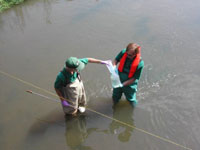Are Pharmaceuticals in Your Watershed? Understanding the Fate of Pharmaceuticals and Other Contaminants in Watersheds
 Plant foliage samples being placed in direct sunlight for water extraction by solar distillation. Water vapor released from the foliage condenses as liquid on the inside surface of the sample bag.
Plant foliage samples being placed in direct sunlight for water extraction by solar distillation. Water vapor released from the foliage condenses as liquid on the inside surface of the sample bag.
(Click on image for larger version) |
 Triclosan, caffeine, and nonylphenol concentration profiles for Boulder Creek, Colorado, showing downstream (left to right) variations during spring-runoff (June 2000). The increase in concentrations in the stream from site aWWTP to site 75 is the result of the discharge from a wastewater treatment plant into Boulder Creek
Triclosan, caffeine, and nonylphenol concentration profiles for Boulder Creek, Colorado, showing downstream (left to right) variations during spring-runoff (June 2000). The increase in concentrations in the stream from site aWWTP to site 75 is the result of the discharge from a wastewater treatment plant into Boulder Creek
(Click on image for larger version, a complete description, and a site map) |
|
In streams and rivers across the Nation, scientists are finding detectable concentrations of pharmaceuticals and other organic wastewater chemicals. For example, a recent study of the water-quality of streams in the Boulder Creek Watershed, Colorado, found a diverse set of pharmaceuticals and organic wastewater chemicals in water samples. In fact, U.S. Geological Survey (USGS) scientists found 12 of the 22 (55 percent) pharmaceuticals, and 32 of the 47 (77 percent) organic wastewater chemicals looked for in the watershed. Many of the water samples contained a complex mixture of pharmaceuticals, wastewater chemicals, pesticides, and trace metals (see supporting information for a full listing). Understanding the fate and ecological effects of this complex chemical mixture on a watershed scale is the objective of a team of USGS scientists studying the Boulder Creek Watershed. The scientists found that:
- The concentration of many of these chemicals, such as sulfamethoxazole (an antibiotic used to treat a wide range of bacterial infections), triclosan (an antimicrobial agent commonly used in soaps), and caffeine, increased dramatically downstream from the first major wastewater treatment plant (see sampling location map). However, some organic wastewater indicators (such as triclosan) were also found in much lower concentrations in the relatively pristine upper part of the watershed, and scientists attributed their occurrence to home septic systems and other sources on the landscape.
- Few of the detected compounds exceeded water-quality standards; however, many do not have water-quality standards. Although it is difficult to assess the potential for adverse ecological effects of such complex chemical mixtures in the wastewater affected part of Bounder Creek (see sampling location map), native fish populations were found to exhibit endocrine disruption, including low male-to-female sex ratio and fish having both female and male reproductive organs (gonadal intersex).
- Identifying what controls the fate and occurrence of chemicals in streams such as Boulder Creek requires an understanding of the diverse factors present in a watershed, such as the geology, ground-water quality, types of ecosystems, multiple contaminant sources, climate, land use, and amount of urbanization.
Water-resource managers can use this watershed approach to understand the complex interaction of a watershed's characteristics (land use, population density, geology, hydrology, …) and the fate and impact of contaminants, such as pharmaceuticals and organic wastewater chemicals, and to make more effective water management policies.
References
- Barber, L.B., Murphy, S.F., Verplanck, P.L., Sandstrom, M.W., Taylor, H.E., and Furlong, E.T., 2006, Chemical loading into surface water along a hydrological, biogeochemical, and land use gradient—A holistic watershed approach: Environmental Science and Technology, v. 40, no. 2, p. 475-486, doi: 10.1021/es051270q. (Supporting Information)
More Information
Related Headlines
Back to Headlines page
|

|